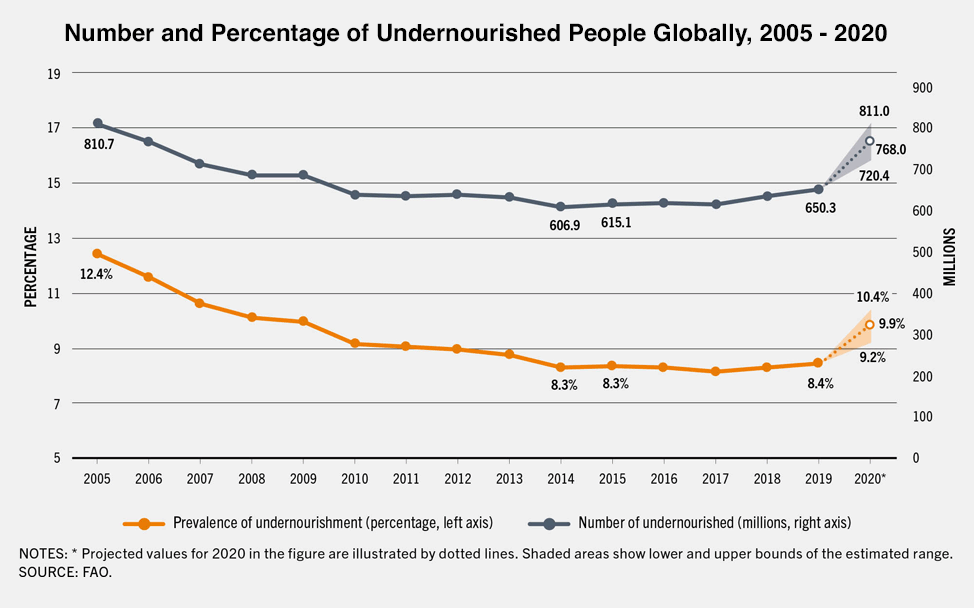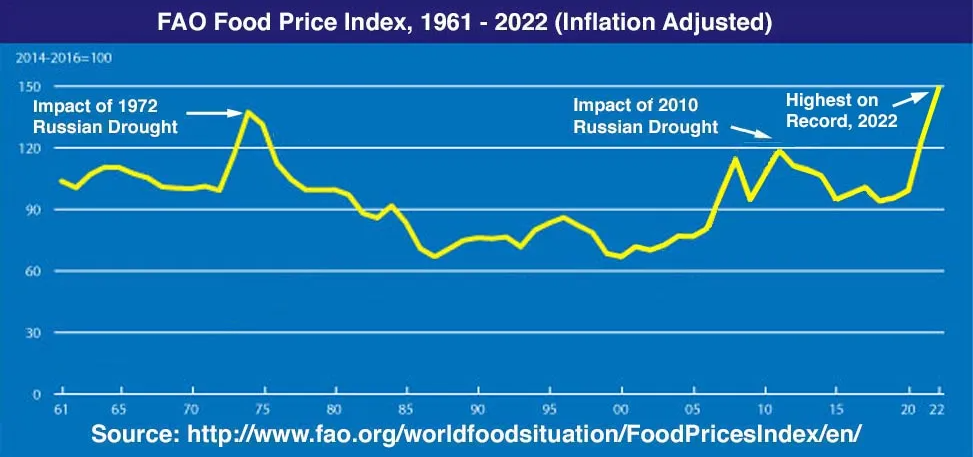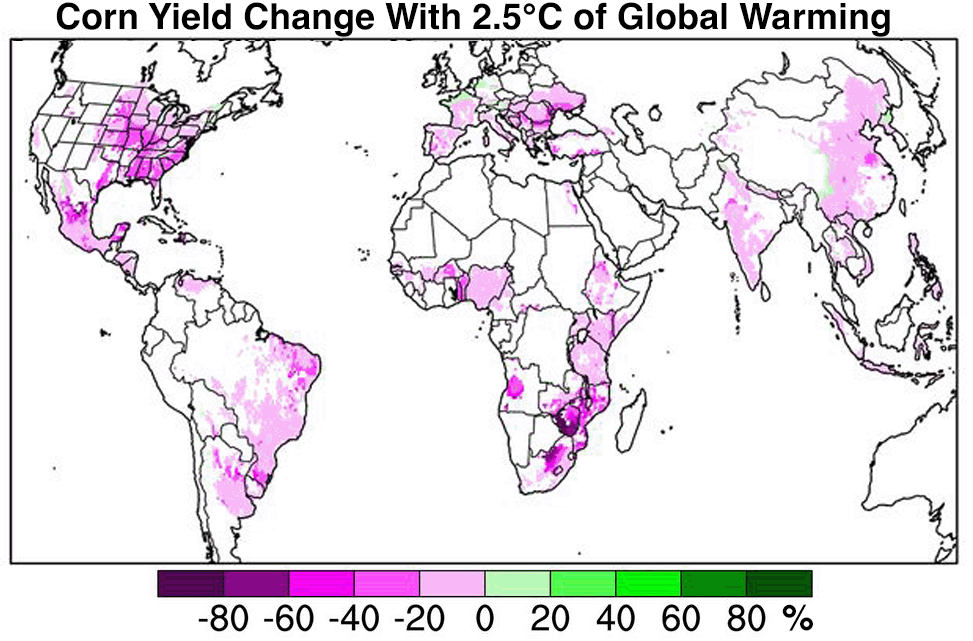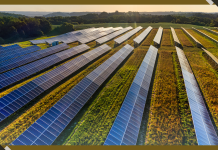Written by: Jeff Masters with contribution from Bob Henson
Increased drought and extreme heat adversely affecting agriculture likely pose the highest threat to civilization over the next 40 years. The greatest danger: extreme droughts supercharged by climate change, affecting multiple grain-growing areas simultaneously, causing “food shock” events that could trigger food prices spikes leading to mass starvation, war, and a severe global economic recession. And the odds of such a globe-shaking food shock event are steadily increasing as humans burn fossil fuels and pump more heat-trapping climate pollutants into the air, increasing the duration, areal coverage, and intensity of droughts.
In this second part of a two-part series on climate change and agriculture, we look at climate change’s likely impacts on the future of agriculture. Part one, Food supply and security concerns mount as impacts stress agriculture, examined observations of how climate change has already affected crops. Here, in part two, we’ll look at such issues as increasing food demand and food insecurity, land degradation, the short- and long-term risks of food system shock, a droughtier world ahead, how corn and wheat will respond in different ways to climate change, and the impact of biofuels. After these admittedly daunting concerns, we’ll also discuss some reasons for hope.
Food demand is steadily growing
A growing population and an increase in demand for meat is expected to cause a 50 percent increase in the food needed to feed Earth’s people between 2010 and 2050. Demand for meat, dairy, and fish is on track to grow by 70 percent or more, and food prices for billions of low-income people are expected to rise 20 percent.
However, a 2019 report by the Global Commission on Adaptation said that without adaptation, climate change may depress growth in global agriculture yields by 5-30 percent by 2050, with the 500 million small farms around the world most affected. At the same time, yields from fishing and aquaculture are expected to decline because of climate change-induced shifts in temperature, chlorophyll, and ocean acidification.

Food insecurity is rising
One of the great achievements of modern society, the “Green Revolution” in agricultural technology, began in the 1960s. As climate change writer Elizabeth Kolbert wrote in The New Yorker at that time, the world population was growing by 2 percent per year, and agricultural productivity was not keeping up. A number of prominent experts predicted catastrophe. The 1968 book by Stanford biologist Paul Ehrlich, “The Population Bomb,” predicted: “The battle to feed all of humanity is over. In the 1970’s the world will undergo famines – hundreds of millions of people are going to starve to death in spite of any crash programs embarked upon now.”
Thankfully, the catastrophe failed to materialize, thanks to the Green Revolution, spearheaded by plant pathologist Norman Borlaug. He painstakingly bred wheat to create a series of highly productive, disease-resistant varieties. Similar work was done by others to improve rice yields. In combination with intensive fertilizer and pesticide use and a major expansion in irrigation, wheat and rice production doubled or tripled in much of the developing world in a span of 20 years. For his efforts, Borlaug was awarded the Nobel Peace Prize in 1970. “More than any other single person of this age, he has helped to provide bread for a hungry world,” the Nobel Committee stated.
The Green Revolution caused the number of undernourished people globally to fall significantly from the 1970s to around 2010. However, this progress halted in the 2010s (Figure 1). According to the United Nations Food and Agricultural Organization, FAO, the number of people undernourished or food-insecure grew between 37 million and 122 million, to more than 800 million, between 2014 and 2017, partly because of climate shocks.
An analysis by George Monbiot found that these climate shocks were exacerbated by financial speculation. He argues that the global food system is displaying many of the same characteristics as the global finance system did shortly before the 2008 financial crisis struck. To avoid a devastating food system crisis, he argues: “We urgently need to diversify global food production, both geographically and in terms of crops and farming techniques. We need to break the grip of massive corporations and financial speculators. We need to create backup systems, producing food by entirely different means. We need to introduce spare capacity into a system threatened by its own efficiencies.”
Monbiot points out that the increasingly interconnected global economy is getting more vulnerable to food shocks, requiring significant changes in the food system. A 2019 paper in Nature Sustainability reports that in the food system, “shock frequency has increased through time on land and sea at a global scale,” with the shocks primarily being geopolitical and extreme weather events.
Food system shock
I outlined such a devastating food system shock scenario last year, which was published in The Hill. In that scenario, an extreme weather onslaught involving historical weather events that have already happened – droughts, floods, and a Hurricane Ida clone that hits during the peak of harvest season, disrupting U.S. exports of grain – causes global food prices to spike to quadruple the levels of 2000. Food riots break out in urban areas across the Middle East, North Africa, and Latin America. European currency weakens and the main European stock markets lose 10 percent of their value; U.S. stock markets fall 5 percent. Civil war threatens to erupt in Nigeria, famine threatens to kill nearly a million people in Bangladesh and Africa, and Mali becomes a failed state. Military tensions heighten between Russia and NATO; nuclear-armed India and Pakistan fight a border skirmish over water rights. Terrorist attacks hit the U.S., causing even more dramatic falls of the stock market, and the global economy tumbles into a deep recession.
A similar scenario was outlined by insurance giant Lloyds of London in a “Food System Shock” report issued in 2015. Lloyds gave uncomfortably high odds of such an event occurring – well over 0.5 percent per year, or more than an 18 percent chance over a 40-year period.

Higher risk of a serious food system shock event through 2023
Given the unprecedented weather extremes that have rocked the world recently, combined with disruptions to the food system from the COVID-19 pandemic, high fertilizer prices, and the war in Ukraine, the odds of a devastating food system shock will be much higher than usual through 2023.
Food prices during the first eight months of 2022 were at an all-time high, adjusted for inflation (Figure 3), and according to the FAO, and all-time high of up to 49 million people in 46 countries are currently at risk of falling into famine or famine-like conditions unless they receive immediate food assistance. The most catastrophic conditions are in Ethiopia, Afghanistan, Somalia, South Sudan and Yemen, where conflict is the primary current driver of food insecurity. If the wrong combination of extreme weather events were to hit multiple grain-producing breadbaskets simultaneously in 2023, a serious food shock event like the Lloyds scenario is possible.
A future with more drought
It is greatly concerning that climate models point to a future with more intense and longer-lasting droughts. For example, Li et al. (2021), Projected meteorological drought over Asian drylands under different CMIP6 scenarios, found that for China, drought duration during 2021–2060 is expected to be 10.8 months, while that of the historical period of 1960–2000 was 6.6 months. Moreover, drought intensity (as measured by an index that takes into account precipitation, solar and infrared radiation, humidity, and wind speed) is predicted to increase by about 40 percent. Cook et al., 2020, Twenty-first century drought projections in the CMIP6 forcing scenarios, projected a factor of 2-3 increase in the most extreme droughts in many crop-growing regions by the end of the century, under a moderate global warming scenario (SSP2-4.5).
What’s more, concurrent droughts, where multiple grain-producing areas might be adversely affected, are expected to increase by 40 percent by 2050, according to Singh et al., 2022, Enhanced risk of concurrent regional droughts with increased ENSO variability and warming. Historically, about 46 percent of compound droughts are associated with El Niño events (and 22 percent during La Niña events), so if an El Niño event occurs in 2023, it will come with the increased risk of concurrent droughts.
A May 2022 UN drought report estimated that by 2050, 4.8-5.7 billion people will live in areas that are water-scarce for at least one month each year, up from 3.6 billion today. Drought is predicted to affect 75 percent of the world’s population by 2050, and could also force 216 million people to migrate – in combination with factors such as declining crop productivity and water scarcity.
Future crop response to climate change: corn suffers, wheat benefits
While a hotter and drier climate is generally more hostile to crops, these losses will be offset to some degree by gains in plant growth from increased carbon dioxide in the air that will stimulate plant growth (the CO2 fertilization effect). In addition, increases in precipitation in some grain-growing regions, along with expansion of crops into areas that were formerly too cold, will also benefit crops.
Sophisticated crop models now attempt to take all these factors into account. The Agricultural Model Intercomparison and Improvement Project looks at the consensus of multiple crop models, and provides a powerful tool for estimating impacts of climate change on agriculture. The most recent results from this project, published in November 2021, gave results for the four main grains that account for nearly 60 percent of the calories grown by farmers: wheat, corn, rice, and soybeans. For corn, the study reported that 85 percent of the model combinations found significant decrease in yields by 2100 from climate change. For wheat, 73 percent of the models predicted an increase in yields. These results were for the most extreme global warming scenario (SSP5-85, which predicts CO2 levels in 2100 will be 1,122 ppm—far above the current value of ~420 ppm). The average yield loss for corn was -24 percent, while the average gain for wheat was +18 percent. Rice and soybean yields remained within 2 percent of current levels. While global warming is very unlikely to reach this extreme level, modeling this scenario is helpful for exploring the trends that are likely to be observed in future corn and wheat yields.
The reason for the predicted increase in wheat yields is that wheat responds strongly to increased CO2. In addition, global warming leads to wheat yield increases in high-latitude regions currently too cold to grow wheat. Corn can benefit less from elevated CO2, and is also grown across a wider range of low latitudes that are projected to experience heat too high for optimum corn growth.
Note that the crop models under-represent such factors as increased pest and disease damage in a warmer climate, loss of pollination as a result of a decline in insect pollinators, reduced irrigation because of excessive groundwater pumping, loss of farmland to sea level rise, and adverse impacts of heavy rainfall events on crop growth in response to lower aeration, waterlogging, and nitrogen leaching. The Agricultural Model Intercomparison and Improvement Project study concluded that even without including these additional adverse effects, climate change will create worrisome risks to agriculture because it will “push global farming outside of its historical regimes.”
Simultaneous extreme heat waves may increase as climate warms
Simultaneous extreme heat waves that challenge agriculture will increase dramatically as the climate warms, according to a 2019 modeling study by Vogel et al., Concurrent 2018 Hot Extremes Across Northern Hemisphere Due to Human-Induced Climate Change. Authors of that paper documented that between May and July 2018, about 22 percent of the populated and agricultural areas north of 30° latitude experienced concurrent hot temperature extremes: events they are virtually certain could not have occurred without human-caused global warming.
Events of this type were unprecedented prior to 2010, and similar conditions were experienced in the summer of 2010 and 2012. The odds of such conditions in a given summer are about 16 percent with one degree Celsius of global warming (global temperatures have risen about 1.2 degrees Celsius since pre-industrial times). The odds of simultaneous heat waves rise steeply with additional warming, with the modeling predicting a 65 percent chance of such conditions each year for 1.5 degrees Celsius of global warming above pre-industrial levels, and a 97 percent chance for 2 degrees Celsius of warming. In addition, the area affected by these concurrent heat extremes expands by about 16 percent per degree Celsius of global warming.

Major corn crop failures are rare, but likely to become common
Climate-induced yield losses of more than 10 percent in a given year in major corn-producing nations are rare, occurring only every 15 to 100 years for the top corn exporting nations: the U.S., Brazil, Argentina, and Ukraine. Furthermore, losses of more than 20 percent in a given year in these nations are virtually unknown, according to a 2018 paper led by Michelle Tigchelaar, Future warming increases probability of globally synchronized maize production shocks.
However, if the climate warms to about 2.5 degrees Celsius above pre-industrial levels (which will occur by the 2080s or 2090s if the globe continues to warm at the current rate of about 0.2 degree Celsius per decade, see Figure 4), the authors found that the probability of a more than 10 percent or 20 percent yield loss in any given year rise steeply. In the U.S., the odds of a 10 percent yield loss would be 69 percent. The odds that all four of these countries will suffer corn crop losses of more than 10 percent in any given year are nil under present-day climate conditions, but rises to 7 percent per year with 2.5 degrees Celsius of warming. The study did not consider the impact of changes in precipitation (and thus drought): Drought impacts are certain to intensify in a hotter climate, so these odds may be considerably underestimated.
Growing more crops on increasingly degraded land will be difficult
The Green Revolution has come at a high cost. As reported in our previous post, Recklessness defined: breaking 6 of 9 planetary boundaries of safety, humanity has pushed the planet beyond the boundary of safety in six ways. The Green Revolution has been a major contributor to crossing three of these boundaries – land system change (e.g., deforestation), biosphere integrity (e.g., species extinction), and biogeochemical flows (pollution of fresh water from nitrogen and phosphorus). In addition, we are in danger of crossing one other boundary – fresh water use – as a result of unsustainable agricultural processes accelerated by the Green Revolution, such as excessive pumping of groundwater.
According to a landmark 2022 report from the United Nations Convention to Combat Desertification (UNCCD), human activities have already altered 70 percent of the Earth’s land surface, degrading up to 40 percent of it. Degraded land – depleted of natural resources, soil fertility, water, biodiversity, trees or native vegetation – is much more difficult to grow crops on. “The treatment of soils with inorganic fertilizers to increase or sustain yields has had significant adverse effects on soil health, and has contributed to freshwater pollution induced by run-off and drainage,” FAO reported in 2021, with 34 percent of the world’s farmlands suffering human-induced degradation. Increasing land degradation presents a big hurdle if we want to increase agricultural production 50 percent by 2050 to feed the world’s billions.
The United Nations Convention to Combat Desertification report projects that on the current trajectory, an additional area almost the size of South America could be degraded by 2050. However, if land protection and restoration are embraced, new “natural areas” about one-quarter the size of South America could be realized by 2050, with benefits for fighting climate change and biodiversity loss. (See the excellent summary from Carbon Brief on the UNCCD report.)
The world badly needs a Green Revolution 2.0, but one that doesn’t impose additional degradation of ecosystems. A 2017 study led by Xin-Zhong Liang, Determining climate effects of US total agricultural productivity, found that by 2035, all the gains achieved from 1981 to 2010 as a result of increased agricultural productivity in the U.S. would be lost under a moderate global warming scenario. “To overcome this loss, the effect of technological advances would have to double to sustain [U.S.] agricultural productivity at the current level,” the authors wrote.
One helpful proposal would be the European Union’s “Nature Restoration Law,” which would set legally binding targets and provide over $100 billion for nature restoration in agriculture, forests, oceans and urban areas. As reported by EurActiv, the aim of the proposal is to restore degraded ecosystems, “in particular those with the most potential to remove and store carbon, and to reduce the impact of natural disasters linked to global warming.”
Biofuels and animal feed
In the U.S., about 40 percent of the corn crop is used to produce biofuels (ethanol). The world population of about 7.95 billion is expected to grow to 10 billion by 2050. If we hope to feed those additional two billion people, converting the cropland used to grow biofuels is an obvious solution – though the political barriers are severe. According to data firm Gro Intelligence, crops converted to fuels could feed 1.9 billion people. While burning biofuels does reduce emissions of heat-trapping greenhouse gases compared to burning fossil fuels, there is a high cost to the environment to grow biofuels: The land use changes involved may increase greenhouse gas emissions, biodiversity is lost, soils are depleted, and water is contaminated with chemical fertilizers. In an article in Bloomberg, David Fickling argues that land-use change emissions make biofuels’ climate benefits much less significant: Palm biodiesel emits twice as much as fossil fuels if deforestation is counted for, and “corn-based ethanol has about two-thirds of the climate impact of gasoline.”
In the U.S., approximately 36 percent of the corn crop is used as animal feed for cattle, pigs and chickens. For corn-fed animals, the efficiency of converting grain to meat and dairy calories ranges from roughly 3-40 percent, depending on the animal production system in question. Do the math: a U.S. cornfield grows enough food to feed 14 people per acre (with a 3,000 calorie-per-day diet). But with the current allocation of corn to make ethanol and feed animals, the end result is enough food to feed just three people per acre. Thus, a major shift by people to a less meat-intensive diet, in combination with using less cropland to make biofuels, would be two key ways to feed a growing population in coming decades.
Reasons for hope
An October 2015 report by the World Bank, Future of Food: Shaping A Climate-Smart Global Food System, outlines a growing and diverse spectrum of practices called “Climate Smart Agriculture,” The report shows it is possible to simultaneously deliver higher agricultural productivity, greater climate resilience, and lower greenhouse gas emissions. Elizabeth Kolbert reports on potentially revolutionary work being done to enhance photosynthesis, including a project based at the University of Illinois called Realizing Increased Photosynthetic Efficiency (RIPE).
Bloomberg reports that scientists in China have developed strains of salt-tolerant “seaweed rice” with hopes of ensuring food security amid sea level rise, and more drought- and heat-resistant strains of wheat are being developed. Smarter crop irrigation techniques have the potential to cut the number of hungry people in half, according to Jägermeyr et al., 2016, Integrated crop water management might sustainably halve the global food gap.
As Jeff Goodell writes at rollingstone.com, “There are lots of things we can do to make ourselves less vulnerable to food shocks and shortages. Growing more local food would make us less dependent on global supply chains; diversifying what we eat, so we are less dependent on wheat and corn; not wasting land to turn food into fuel, so that the land can be used to grow food for people who are hungry; using better data to understand exactly how much water and fertilizer crops need, so farmers can reduce the waste; fermenting foods from fungi and developing cell-based meats, so that cheap proteins can be grown with far less land and water use. We’re going to need all of these solutions – and many more – to feed the world in the coming decades.”
While the Green Revolution has been remarkably successful at feeding our growing population, that progress has come at a very steep cost. Much of the wealth we have achieved is borrowed wealth, borrowed from future generations, and we’ve charged our planetary credit cards to the hilt. It’s payback time, and Mother Nature is a very unforgiving lender – she abides by the laws of physics. We have no choice but to repay the loans we have taken out from Mother Earth, and to dramatically transform our food system for the 21st century climate in a sustainable way that does not damage key Earth ecosystems.
Header Image Credit: Quaritsch Photography/Unsplash
This article originally appeared on Yale Climate Connections







